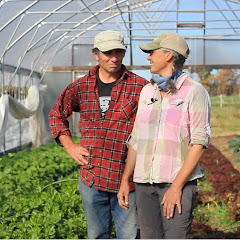The years were flying by 2009. Entering our sixth season of the CSA, we were starting to feel comfortable with growing vegetables for over 100 families. Our original business plan was based on supporting the farm with a CSA membership of 100 shares, but we realized that a more realistic goal was a bit more than that in order to be economically sustainable. To continue to grow we would need not only more members, but also more full-time farm workers.
 |
| January at the pond |
We were able to grow enough crops in 2009 to sell 115 CSA shares. The Fair Share Farm CSA Core Group continued their stellar work of running the organization as it grew: the Spring sign-up meeting, coordinating the farm work schedule, surveying the membership and expanding distribution.
 |
| Gary Glauberman and Kelly Parker helping with contracts at the Spring Sign-up |
By the start of the season we hired two full-time apprentices. Lori Watley was a friend of the farm who had helped us often during 2005. Kara Jennings was so enthusiastic to apprentice with us that she drove in from Gladstone every day to learn the trade. Kara and Lori made the season what we called our best year
yet.
 |
| Kara and Lori at the wash sink |
 |
| Jeff and his son helping in the Spring 2008 |
A regular volunteer in 2008 and 2009, Jeff Hunter also was a big help in those years. He and his wife Stacey started a large garden at their local church, helped create a learning garden for kids, and now farm their own land.
In 2009 we made a big shift in our greenhouse production. We had been experimenting over the previous couple seasons with the use of soil blocks for starting our transplants. We had found they created plants that were more robust, greener, held longer in the greenhouse, and experienced less transplant shock than plugs.
 |
| Soil blocks in the greenhouse |
 |
| A flat of nice cabbage plants |
When the harvest came in we couldn't complain. Shares were full, filled by the harvest of 835 quarts of strawberries, 1,000+ lbs of beans, melons for all, great brassicas, and a stellar fall carrot and beet crop.
All this with the same annual rainfall (44+ inches) as the previous year. While the rain fell in less of a downpour pattern than 2008, our adjustments to how we prepared the ground also helped keep the crops out of the muck.
This was also to be the year that our cover cropping program came to life. We had initated an annual system whereby we plant oats and vetch in April, turn the crop under in June/July, and plant the bed in fall vegetables in August. We had a very good cover crop that year and the carrots and beets in those beds grew like none we had seen previously.
 |
| Strawberry harvest at its best |
 |
| The Rouyer Family picking peas |
 |
| Bean picking crew returning with their harvest |
 |
| Sweet peppers |
 |
| Watermelons for all |
That year, we experimented with raising livestock. We borrowed six of Parker Farms' sheep to reduce our mowing needs, apply some fertility to areas of ground yet to be broken, and learn about caring for livestock. It was fun and a success.
 |
| Katahdin sheep borrowed from Parker Farms |
Bees proved to be a harder project. We had everything in place; an experienced beekeeper in member Keith Stubblefield, new hive boxes put together with the members' help, organic fields, and thousands of bees bought in their packages. But alas, for the next 3 seasons we could not develop a strong hive, and very little honey was drawn while most of the hives disappeared. The experts call the phenomenon Colony Collapse Disorder, a generic term that describes a problem with no known cause.
 |
Ann Flynn, Fran Gillespe, Keith and Nancy Stubblefield
building the hive boxes |
 |
| Bees but little honey |
Rocky continued to grow and make friends, among them Nora Gibbons. Her parents, Heather and Scott, have been CSA members since our second season in 2005. As Heather was pregnant then, Nora has the distinction of being the oldest person to have been in the CSA her whole life!
 |
| Nora and Rocky |
That Winter we drove down to Texas as part of an annual trip for Rebecca and her snow-bird, Grandmother Kathleen. It was a chance for me to meet her many cousins, uncles, nieces and nephews in the Lone Star State. When back at the farm we planned and studied. One such science project included looking at our compost through our microscope and realizing I could film it. Those critters are called springtails.
 |
| Rocky in December |
Next up...2010 and lots of heat, learning to gutter, best winter squash, solar stimulus and a wedding day.































































